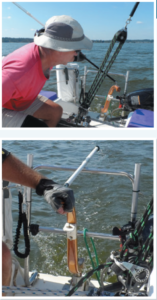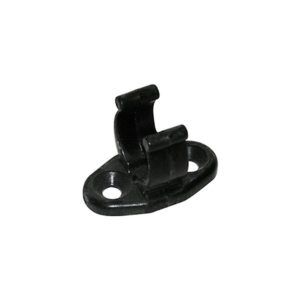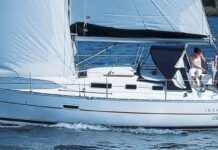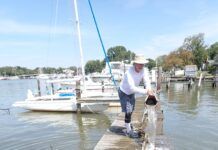
Using an extension adds one more element to tacking, either a nuisance or a benefit, depending on how it is handled. Like most things sailing, there is no single best way, only trends within certain geometries. For dinghies, there are many excellent boat-specific videos online. For the rest of us, there are these general rules:
Tacking
If the tiller and helmsman are in front of the traveler, start the tack holding the extension in the same hand as before the tack in a dagger grip. Facing forward, push the tiller across. As soon as the rudder is hard over, pass the extension across forward, being careful not to mow down your crew. Alternatively, you can wait until near the end of the tack, but soon after the start seems less hectic.
If the tiller and helmsman are behind the traveler, proceed as above but using a golf grip and passing the extension aft. The extension may also be passed in a more vertical position, since it may be behind the boom.
If the tiller is behind the traveler and the helmsman is in front of the traveler (common on smaller multihulls), hold the extension in the aft hand with a golf grip, face aft, passing the extension behind the mainsheet just as the tack begins, preferably before the rudder is hard over since this results in a shorter arm reach.
If the extension is long it is very helpful to hold it vertically, close behind the boom (see photo); this reduces the weight and makes for an easy pass. As you move across, switch hands and sit down on the new side. Somewhere in that process you pass the mainsheet from hand-to-hand.
Because you are reaching around the mainsheet tackle, this won’t work for jibing unless the traveler is centered and fixed. To jibe, either center the traveler, park the extension in a holder, or pass the extension before the jibe begins. You don’t want to be reaching around the mainsheet during the jibe. The best practice is generally to park the extension and use the tiller directly.
If the extension is very long (as with some trimarans) twin extensions can be used. The unused extension is typically kept in position along the rail by light bungee cords. It must be long enough not to jam on something when pulled inboard and then back out, but not so long as to drag in the water.
If it seems like there’s too much going on, park the extension during tacks and jibes.

A Place to Park
There will be times when you want to put the extension down and just steer with the tiller.
Do not simply drop the extension. Except for the lightest dinghy sticks with polymer hinges, which stand straight up when released, the extension will jam against something, locking the helm at the worst moment. Dropped overboard it will drag in the water and be difficult to recover.
Our Stiletto 27 had a cradle on the tiller cross arm where it could be rested when not in use (see photo this page). Many sailors add a boat hook clip to the top of the tiller, about 1-foot aft of the pivot, and clip it there. On our Corsair F-24, we added horns to the stern rail, providing a safe resting place for even our 8-foot extension.
Auto-pilot
There are also times when a tiller pilot or tiller lock is the better answer. A tiller extension does not allow you to move everywhere or use both hands. A tiller extension lock box, in combination with an adjustable extension, is sometimes heralded as a tiller lock and auto-pilot substitute.
In our experience, these are useful for preventing the rudder from flopping around at anchor but are not for holding course; they are just too fiddly to adjust. See “Tiller Taming with Two Fingers,” Practical Sailor, December 2014. As for tiller pilots, I’ve had Raymarine ST2000s on two boats and liked them. Renowned West Coast sailor Skip Allan reported on these in the June 2009 issue of Practical Sailor.






























